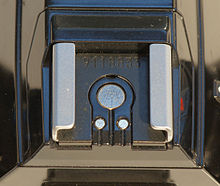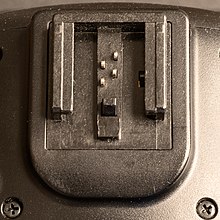iISO flash shoe



iISO (intelligent
.History
The mechanical design of the accessory shoe now common on most cameras dates back to 1913, when Oskar Barnack, the inventor of the Leica, devised it for attaching an accessory viewfinder.[2] By the 1940s, with the addition of the central contact, the design became commonly used for attaching and triggering accessory flashes and known as the "hot-shoe". Prior to 1988, Minolta has used that familiar, common hot-shoe design, adding, just like the other makers, its own proprietary contacts for enhanced control.
In 1988, Minolta introduced the iISO flash shoe in its new i series of cameras. Reportedly conceived with the input from Herbert Keppler in 1987, the new Minolta patented design[3] featured a push-button latching mechanism, for the purpose of easier and faster flash attachment and removal and a more secure hold.
On 12 September 2012, Sony introduced a new 21+3-pin metal-based hotshoe with mechanical quick locking mechanism, called Multi Interface Shoe. At first sight it resembles a standard ISO 518 hotshoe with just the middle contact and chassis and without any vendor-specific extra contacts, but additional contacts are hidden under the front of the hotshoe. The new hotshoe is mechanically incompatible with the iISO hotshoe, but electrically backwards compatible. The first cameras to use the new hotshoe are the SLT-A99, NEX-6, NEX-VG900, NEX-VG30 and DSC-RX1. An ADP-MAA adapter to the iISO flash shoe is however provided with the Sony SLT-A99, and the newest flash Sony HVL-F60M, which uses the new hotshoe comes with a reverse adapter ADP-AMA for older Sony and Minolta cameras.
The last cameras introduced utilizing the iISO hotshoe in 2012 were the
Design
Mechanical
The use of the button-operated latch, besides facilitating a quick, one-handed flash attachment and detachment, also eliminates the possibility of the flash gradually working itself loose and shifting in the shoe, which on camera systems using the ISO 518 hot-shoe can lead to certain contacts being broken, contacts with the wrong pins being made, or in extreme cases the flash sliding off the hot-shoe entirely.
- Attachment
As the flash slides onto the camera body, the sides of the T-shaped flange on the body engage the lips of the rotated C-shaped profile on the flash. When the flash is fully inserted, a spring-loaded latch on the flash locks into the indentation in the middle of the flash shoe. - Detachment
The user presses the unlock button on the flash body, which, by means of a lever or a wedge mechanism disengages the locking latch, enabling the user to slide off the flash from the camera body.
Electronic Contacts
Listed top-to-bottom (looking at the flash shoe socket as pictured above, or with the camera positioned with the lens pointing up):
| Pin | Wire | Analog | Digital |
|---|---|---|---|
| F3 | black | TTL OK | Clock |
| F2 | white | Ready | Bidirectional serial data |
| G | blue | Ground | Ground |
| F1 | red | Sync / trigger flash | -- |
Variations
- Analog and digital control modes
Digital control mode is used if a contemporary flash is detected by the camera. Otherwise, to support basic triggers and legacy and low-end flashes, analog interface is used.[5] - Additional electronic contacts on Minolta 3000i/3700i
This low-end body omitted a built-in flash, and Minolta made available D-314i and D-316i compact and inexpensive flashes especially for it. These flashes relied on camera battery for power delivered via three additional pins on the hot shoe (+5V regulated and switched flash electronics power via an additional contact in the upper corner of the right contact column, and unregulated power and ground wired to the camera's battery to charge the flash via two high-power contacts located underneath the left and right rails). No other camera body has the additional contacts required to support the D-314i and D-316i flashes.[6]
Criticism
The iISO hot shoe's introduction left few informed users indifferent - some photographers loved it, while others hated it. The sentiment revolves around these areas:
- Legacy support
During its 1988 introduction, the new Minolta iISO flash shoe presented an inconvenience to users with significant investment in the old, ISO 518 based Minolta flashes and accessories. The fact that Minolta chose to offset the new flash shoe introduction by three years from the 1985PC terminal was made available by the Minolta service at request at least in Germany and the US, this part was also mentioned in the Minolta USA FAQs under the unofficial name "FS-PC" (8825-0000-00).[7] - Interoperability across systems
It is possible to mount, say, a YN-H3. - There are also wireless radio triggers for the iISO flash shoe available, like the PixelPawn TF-363, the Phottix Strato II and many other systems.
References
- ^ a b Photography -- Camera accessory shoes, with and without electrical contacts, for photoflash lamps and electronic photoflash units -- Specification, 2006 revision. 2006. Archived from the original on 2016-07-11. Retrieved 2016-07-11.
- PopPhoto (blog). Archivedfrom the original on 2016-07-11. Retrieved 2016-07-11.
- ^ Paul, Matthias R. (2009-02-09). "Detailing the Minolta hotshoe patents" (in German). Minolta-Forum. Archived from the original on 2016-07-11. Retrieved 2016-07-11.
- ^ Paul, Matthias R. (2009-04-20). "On trigger circuit voltages, also describing the evolution of the Minolta hotshoe pinout over the decades" (in German). Minolta-Forum. Archived from the original on 2016-07-11. Retrieved 2016-07-11.
- ^ Paul, Matthias R. (2004-11-16) [1990]. "On the Minolta flash protocol - first known public description of parts of the digital data format" (in German). Minolta-Forum. Archived from the original on 2016-07-11. Retrieved 2016-07-11.
- ^ Paul, Matthias R. (2005-03-03) [1990]. "On various camera and accessory pinouts - first known public description of the various hotshoe signals, origin of naming conventions" (in German). Minolta-Forum. Archived from the original on 2016-07-11. Retrieved 2016-07-11.
- ^ Paul, Matthias R. (2011-05-03). "Detailing the Minolta FS-PC internals" (in German). Minolta-Forum. Archived from the original on 2016-07-11. Retrieved 2016-07-11.
- ^ "Sony FA-HS1AM". Sony. Retrieved 2016-07-11.
- ^ Paul, Matthias R. (2009-07-11). "Name of Sony mount adapter for HVL-RLAM ring light" (in German). Archived from the original on 2016-07-11. Retrieved 2015-06-28.
